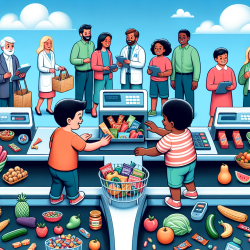Introduction
The pervasive presence of candy, snack foods, and sugary beverages in retail checkout lines has been a topic of concern, especially in the context of childhood obesity. The research article "Candy, Snack Food, and Soda in the Checkout Lines of Stores Selling Products for Children in New York City" sheds light on this issue. As practitioners in the field of speech-language pathology, understanding these environmental factors can aid in developing comprehensive strategies to support healthier lifestyle choices among children.
Research Insights
The study conducted in New York City observed 22 retail chain stores that sell products for children. The findings revealed that 77.27% of these stores sold at least one type of convenience food or sugary beverage at the checkout lines. This setup encourages impulse buying, which can contribute to poor dietary habits among children.
Notably, the study highlighted that nearly all stores selling convenience food offered candy, with 100% of non-corral-style lines and 76.92% of corral-style lines featuring these items. The strategic placement of these products is a marketing tactic that influences consumer behavior, particularly impacting children who are susceptible to impulse purchases.
Implications for Practitioners
For practitioners, these findings underscore the importance of considering environmental factors when addressing childhood obesity. Here are some actionable insights:
- Educate Families: Provide families with information on how retail environments can influence dietary choices. Encourage them to plan purchases ahead of time to avoid impulse buys.
- Advocate for Policy Changes: Support initiatives that aim to regulate the placement of unhealthy foods in retail environments. The City Council in Berkeley, California, serves as a model by banning unhealthy foods from checkouts at large retailers.
- Integrate Nutrition Education: Incorporate nutrition education into therapy sessions, emphasizing the impact of diet on speech and language development.
Encouraging Further Research
The study's limitations, such as its non-generalizable results due to the cross-sectional design and convenience sampling, highlight the need for further research. Practitioners are encouraged to explore additional studies that examine the impact of retail environments on childhood obesity and consider how these findings can be integrated into practice.
Conclusion
Understanding the role of environmental factors in childhood obesity is crucial for practitioners aiming to improve health outcomes for children. By leveraging research insights and advocating for policy changes, we can contribute to creating healthier environments that support children's well-being.
To read the original research paper, please follow this link: Candy, Snack Food, and Soda in the Checkout Lines of Stores Selling Products for Children in New York City.










